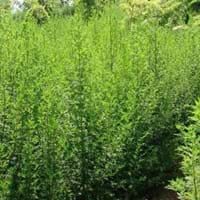Life Span
Perennial
Annual
Type
Bulb or Corm or Tuber
Shrub
Origin
South America
Hybrid origin
Types
Pamianthe cardenasii , Pamianthe parviflora , Pamianthe peruviana
Not available
Number of Varieties
Not Available
Habitat
All sorts of environments
Subtropical forests, Tropical Forests
USDA Hardiness Zone
8-10
Not Available
Sunset Zone
21,22
Not Available
Habit
Clump-Forming
Upright/Erect
Flower Color
White
Not Available
Flower Color Modifier
Bicolor
Not Available
Fruit Color
Green
Not Available
Leaf Color in Spring
Dark Green
Not Available
Leaf Color in Summer
Light Green
Not Available
Leaf Color in Fall
Several shades of Green
Not Available
Leaf Color in Winter
Light Green
Not Available
Leaf Shape
Strap shaped
bipinnate
Plant Season
Spring, Summer, Fall
Spring, Summer, Fall
Sunlight
Partial Sun, Partial shade
Full Sun, Partial Sun
Type of Soil
Loam, Sand
Loam, Sand
The pH of Soil
Acidic, Neutral, Alkaline
Acidic, Neutral
Soil Drainage
Average
Well drained
Bloom Time
Spring, Late Spring, Early Summer, Summer, Late Summer
Not Available
Tolerances
Drought
Drought, Salt
Where to Plant?
Ground, Pot
Ground, Pot
How to Plant?
Offsets
Seedlings
Plant Maintenance
Medium
Medium
Watering Requirements
Keep the ground moist but not water-logged
Average Water Needs
In Summer
Lots of watering
Lots of watering
In Spring
Moderate
Moderate
In Winter
Average Water
Average Water
Soil pH
Acidic, Neutral, Alkaline
Acidic, Neutral
Soil Type
Loam, Sand
Loam, Sand
Soil Drainage Capacity
Average
Well drained
Sun Exposure
Partial Sun, Partial shade
Full Sun, Partial Sun
Pruning
Pinch or prune as they grow to promote branching and bushiness, Remove damaged leaves, Remove dead branches, Remove dead leaves, Requires little pruning
Remove damaged leaves, Remove dead branches, Remove dead leaves
Fertilizers
All-Purpose Liquid Fertilizer, High phosphorus
All-Purpose Liquid Fertilizer, Apply N-P-K
Pests and Diseases
Leaf spot, Mosaic viruses
Aphids, Gray leaf blight, Root rot
Plant Tolerance
Drought
Drought, Salt
Flowers
Showy
Insignificant
Flower Petal Number
Single
Not Available
Fragrant Bark/Stem
No
Yes
Foliage Texture
Coarse
Not Available
Foliage Sheen
Glossy
Not Available
Attracts
Bees, Birds, Bumblebees, Butterflies, Hummingbirds, pollinators
Insects, Not Available
Aesthetic Uses
Beautification, Bouquets, Ornamental use, Showy Purposes
Not Used For Aesthetic Purpose
Beauty Benefits
No Beauty Benefits
Skin inflammation
Environmental Uses
Air purification
Air purification
Medicinal Uses
No Medicinal Use
Antioxidants, Fever, Inflammation, Malaria
Part of Plant Used
Not Available
Leaves
Other Uses
Beneficial species for attracting pollinators, Decoration Purposes
Medicinal oil, Oil is used for aromatherapy
Used As Indoor Plant
No
No
Used As Outdoor Plant
Yes
Yes
Garden Design
Bog Garden, Container, Feature Plant, Foundation, Mixed Border, Water Gardens
Foundation, Mixed Border, Rock Garden, Wall
Botanical Name
HYMENOCALLIS longipetala
Artemisia annua
Common Name
Peruvian Daffodil, Spiderlily
sweet wormwood, sweet annie, sweet sagewort, annual mugwort
In Hindi
peruvian daffodil
Artemisia
In German
peruvian daffodil
Artemisia
In French
peruvian daffodil
Artemisia
In Spanish
Pamianthe
Artemisia
In Greek
peruvian daffodil
Αρτεμίσια
In Portuguese
peruvian daffodil
Artemisia
In Polish
peruvian daffodil
Artemisia
In Latin
peruvian daffodil
Artemisia
Phylum
Magnoliophyta
Magnoliophyta
Class
Liliopsida
Magnoliopsida
Order
Asparagales
Asterales
Family
Amaryllidaceae
Asteraceae
Genus
Pamianthe
Artemisia
Clade
Angiosperms, Monocots
Angiosperms, Asterids, Eudicots
Tribe
Clinantheae
Anthemideae
Subfamily
Amaryllidoideae
Asteroideae
Number of Species
Not Available
Properties of Peruvian Daffodil and Artemisia
Wondering what are the properties of Peruvian Daffodil and Artemisia? We provide you with everything About Peruvian Daffodil and Artemisia. Peruvian Daffodil doesn't have thorns and Artemisia doesn't have thorns. Also Peruvian Daffodil does not have fragrant flowers. Peruvian Daffodil has allergic reactions like Unknown and Artemisia has allergic reactions like Unknown. Compare all the properties and characteristics of these two plants. Find out which of these plant can be used as indoor plant. If you are interested to decorate your house and garden, find out aesthetic uses, compare them and select the plant which will beautify your surrounding. Along with beautification, try comparing medicinal and edible uses of Peruvian Daffodil and Artemisia and you can choose the plant having best and most benefits.
Season and Care of Peruvian Daffodil and Artemisia
Season and care of Peruvian Daffodil and Artemisia is important to know. While considering everything about Peruvian Daffodil and Artemisia Care, growing season is an essential factor. Peruvian Daffodil season is Spring, Summer and Fall and Artemisia season is Spring, Summer and Fall. The type of soil for Peruvian Daffodil is Loam, Sand and for Artemisia is Loam, Sand while the PH of soil for Peruvian Daffodil is Acidic, Neutral, Alkaline and for Artemisia is Acidic, Neutral.
Peruvian Daffodil and Artemisia Physical Information
Peruvian Daffodil and Artemisia physical information is very important for comparison. Peruvian Daffodil height is 61.00 cm and width 61.00 cm whereas Artemisia height is 150.00 cm and width 150.00 cm. The color specification of Peruvian Daffodil and Artemisia are as follows:
Peruvian Daffodil flower color: White
Peruvian Daffodil leaf color: Dark Green
Artemisia flower color: Not Available
- Artemisia leaf color: Not Available
Care of Peruvian Daffodil and Artemisia
Care of Peruvian Daffodil and Artemisia include pruning, fertilizers, watering etc. Peruvian Daffodil pruning is done Pinch or prune as they grow to promote branching and bushiness, Remove damaged leaves, Remove dead branches, Remove dead leaves and Requires little pruning and Artemisia pruning is done Remove damaged leaves, Remove dead branches and Remove dead leaves. In summer Peruvian Daffodil needs Lots of watering and in winter, it needs Average Water. Whereas, in summer Artemisia needs Lots of watering and in winter, it needs Average Water.





